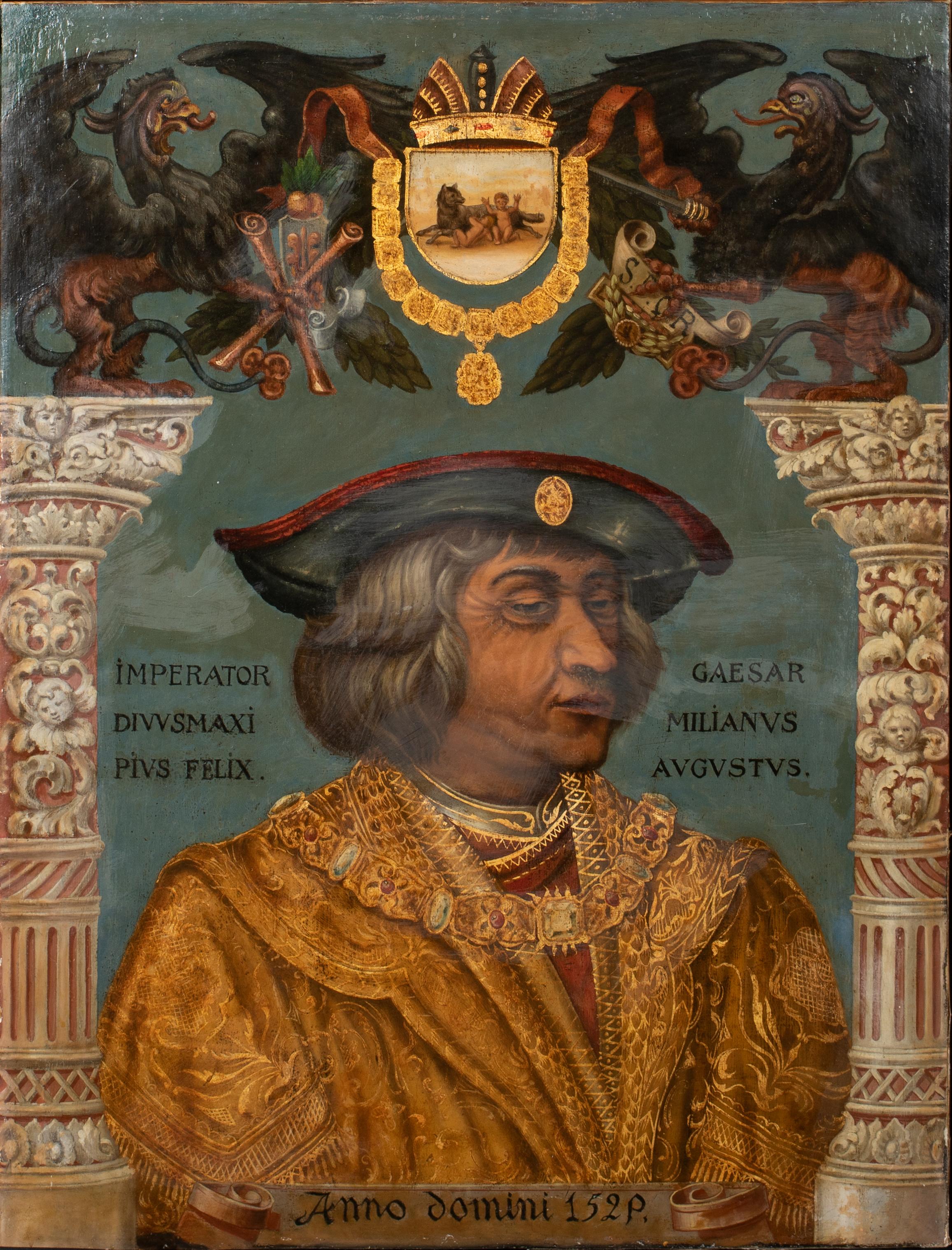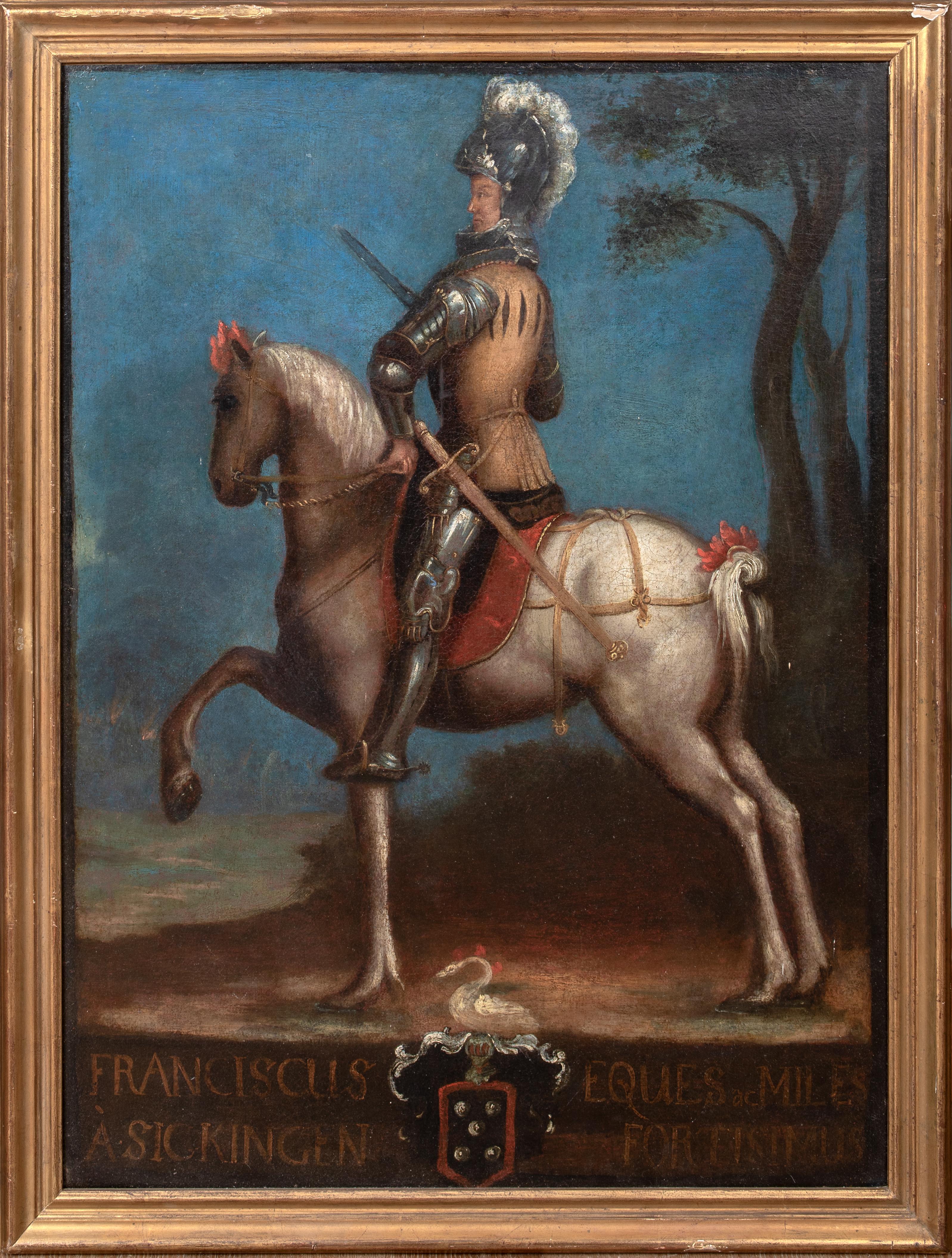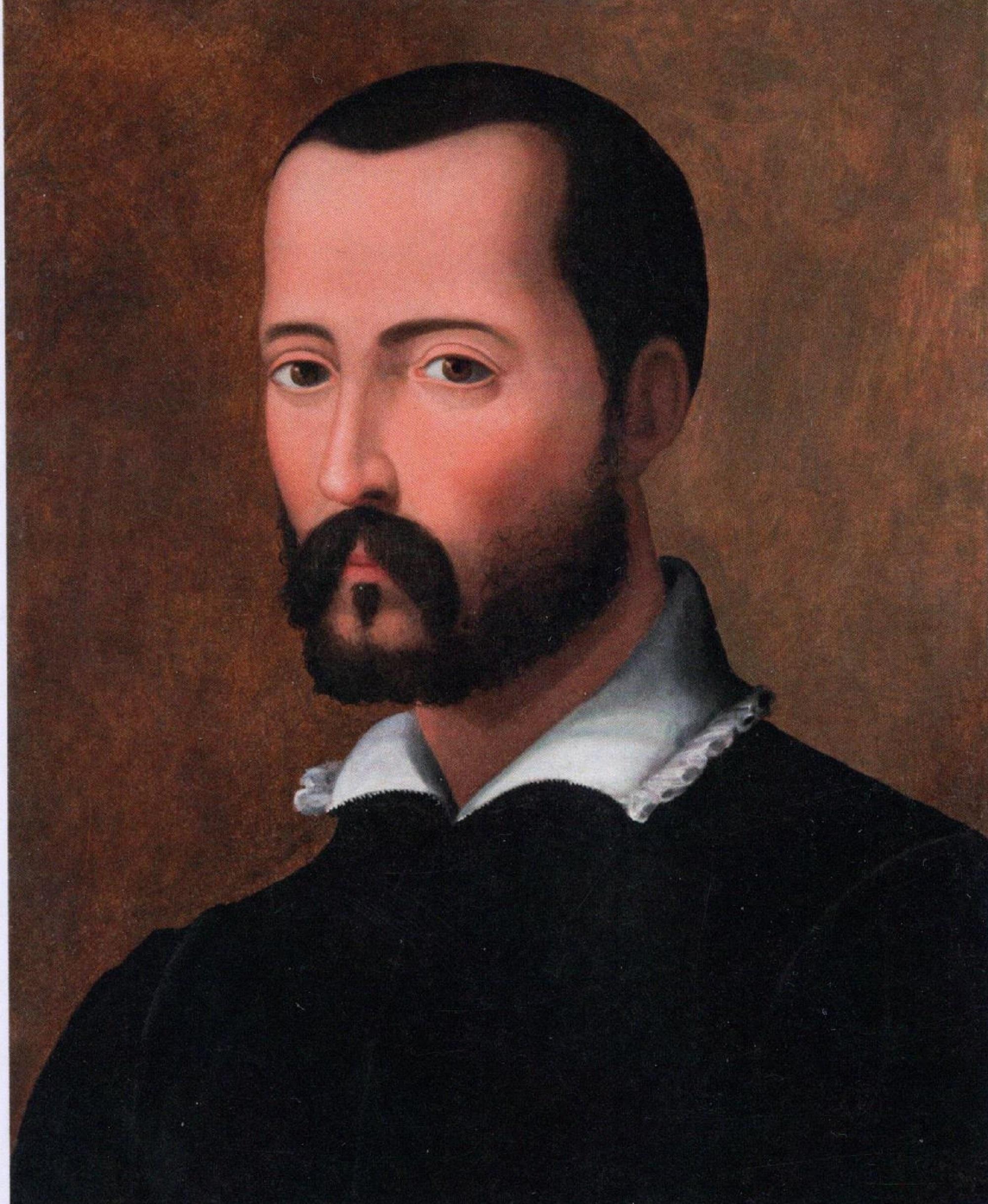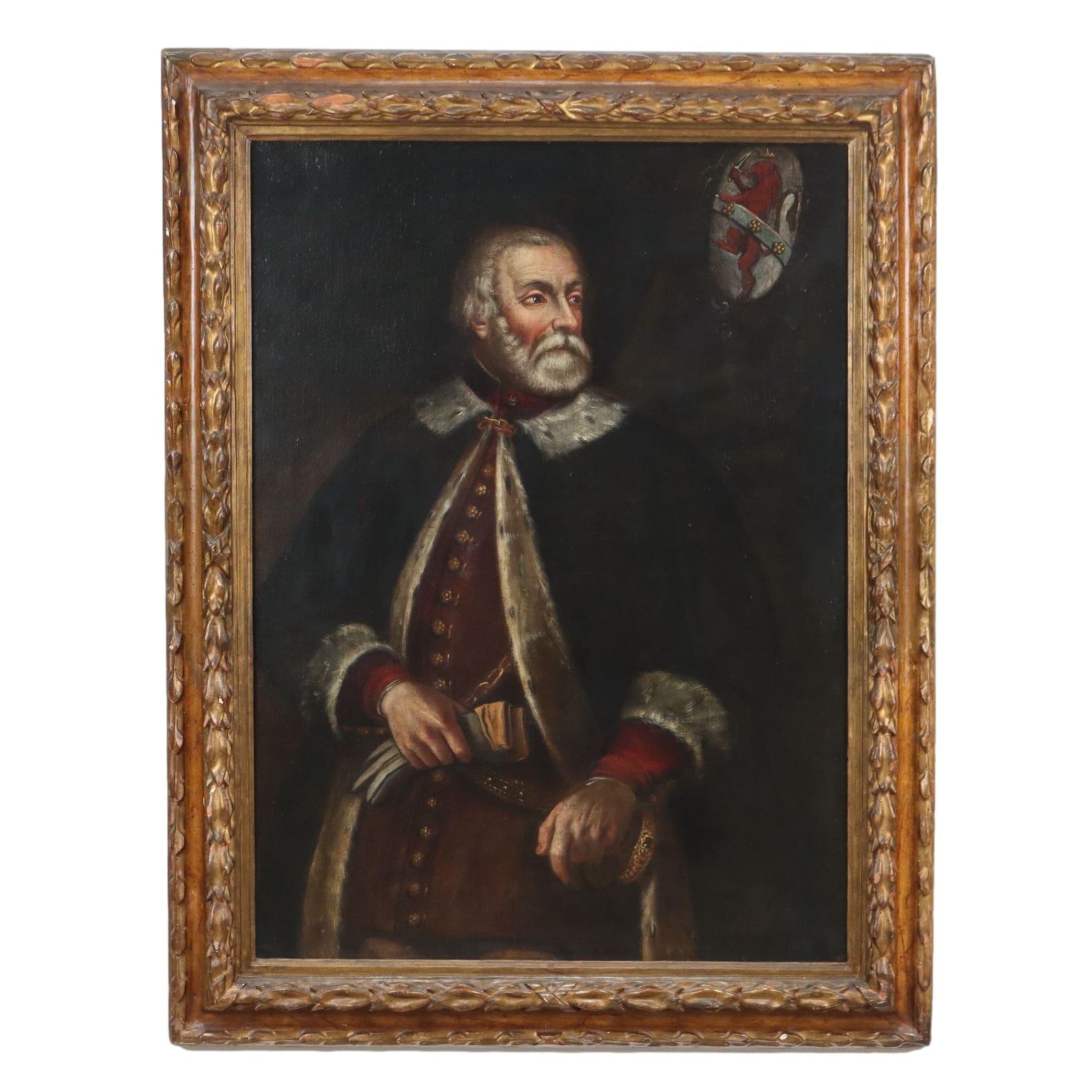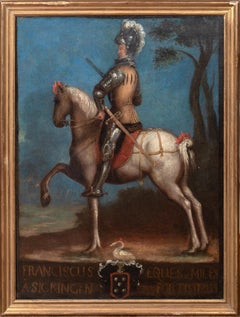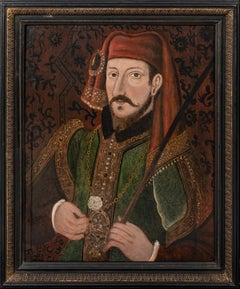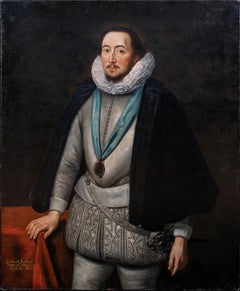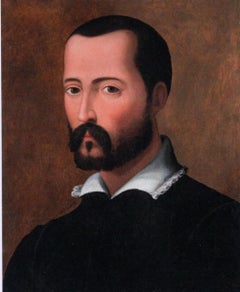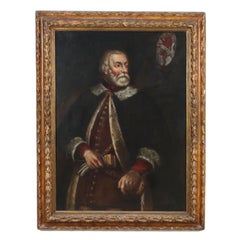Items Similar to Portrait Of Palatine Matthew III Csák of Trencin (1260-1321) Italian School
Want more images or videos?
Request additional images or videos from the seller
1 of 10
UnknownPortrait Of Palatine Matthew III Csák of Trencin (1260-1321) Italian School
$6,713.36
£4,900
€5,725.27
CA$9,346.26
A$10,223.39
CHF 5,345.05
MX$123,143.67
NOK 66,805.67
SEK 63,021.77
DKK 42,738.52
About the Item
Portrait Of Palatine Matthew III Csák of Trencin (1260-1321)
Italian School - Circle of TITIAN
Large 16th Century Italian School portrait of a Matthew III Csak Of Trencin, oil on canvas. Superb quality and condition rare portrait of the Hungarian nobleman who opposed Andrew III. There is only an old engraving identical to this suggesting this is the original portrait Presented in an antique gilt frame.
Provenance: The deceased estate of a gentleman, Edinburgh, Scotland
Measurements: 35" x 28 framed approx
- Dimensions:Height: 32 in (81.28 cm)Width: 28 in (71.12 cm)
- Medium:
- Period:
- Condition:
- Gallery Location:Blackwater, GB
- Reference Number:1stDibs: LU1577215348432
About the Seller
4.9
Gold Seller
Premium sellers maintaining a 4.3+ rating and 24-hour response times
Established in 2008
1stDibs seller since 2021
297 sales on 1stDibs
Typical response time: 1 hour
- ShippingRetrieving quote...Shipping from: Blackwater, United Kingdom
- Return Policy
Authenticity Guarantee
In the unlikely event there’s an issue with an item’s authenticity, contact us within 1 year for a full refund. DetailsMoney-Back Guarantee
If your item is not as described, is damaged in transit, or does not arrive, contact us within 7 days for a full refund. Details24-Hour Cancellation
You have a 24-hour grace period in which to reconsider your purchase, with no questions asked.Vetted Professional Sellers
Our world-class sellers must adhere to strict standards for service and quality, maintaining the integrity of our listings.Price-Match Guarantee
If you find that a seller listed the same item for a lower price elsewhere, we’ll match it.Trusted Global Delivery
Our best-in-class carrier network provides specialized shipping options worldwide, including custom delivery.More From This Seller
View AllPortrait Of Maximilian I Holy Roman Emperor & Archduke of Austria, 17th Century
Located in Blackwater, GB
Portrait Of Maximilian I Holy Roman Emperor & Archduke of Austria, 17th Century
follower of Giulio Romano (1492-1546)
Fine large 16th Century Italian S...
Category
17th Century Portrait Paintings
Materials
Oil, Canvas
Portrait Of Franz von Sickingen Knight Of The Holy Roman Empire (1481-1523)
Located in Blackwater, GB
Portrait Of Franz von Sickingen Knight Of The Holy Roman Empire (1481-1523)
Italian School
Large 16th/17th Century Italian Old Master portrait of Franz von Sickingen, Knight Of The...
Category
17th Century Portrait Paintings
Materials
Canvas, Oil
Portrait of Henry IV, King of England (1367-1413), 16th Century
Located in Blackwater, GB
Portrait of Henry IV, King of England (1367-1413), 16th Century
English School Portrait - Early Oil On Panel
Large 16th Century court portrait of Henry IV, King Of England (1367-14...
Category
16th Century Portrait Paintings
Materials
Oil, Wood Panel
Portrait Of Gilbert Talbot 7th Earl of Shrewsbury (1552-1616), 16th Century
Located in Blackwater, GB
Portrait Of Gilbert Talbot 7th Earl of Shrewsbury (1552-1616), 16th Century
Circle of George Gower (c.1540–1596)
Huge 16th Century Portrait Of Gil...
Category
18th Century Portrait Paintings
Materials
Canvas, Oil
Portrait of Osman I (1254-1323), 17th Century follower of PAOLO VERONESE (
By Paolo Veronese
Located in Blackwater, GB
Portrait of Osman I (1254-1323), 17th Century
follower of PAOLO VERONESE (1528-1588)
Large 17th Century Italian School portrait of Osman I, oil on canvas. Excellent quality and con...
Category
19th Century Portrait Paintings
Materials
Canvas, Oil
Portrait Of A Piedmont Nobleman & Military Officer, House Of Savoy, early 18th c
Located in Blackwater, GB
Portrait Of A Piedmont Nobleman & Military Officer, House Of Savoy, early 18th century
Italian School
Fine large 18th Century portrait of a Piedmont ...
Category
18th Century Portrait Paintings
Materials
Canvas, Oil
You May Also Like
Portrait Knight Paint Oil on canvas 17th Century Lombard school Old master Italy
Located in Riva del Garda, IT
Lombard painter of the 17th century
Portrait of a Knight in Armour
Oil on canvas
81 x 70 cm./ Framed 93 x 82
A handsome gentleman in armour, immortalised in an authoritative and pr...
Category
17th Century Old Masters Paintings
Materials
Oil
$6,082 Sale Price
20% Off
16th Century by Giovanni Maria Butteri Portrait of Francesco I Oil on Panel
Located in Milano, Lombardia
Giovanni Maria Butteri (Florence, Italy, 1540 - 1606)
Title: Portrait of Francesco I
Medium: Oil on panel
Dimensions: without frame cm. 47.7 x 39 - with frame cm. 55.2 x 46.5
Expertise by Carlo Falciani, art historian
Fairs: The International Biennial of Antiques in Florence 2024 (BIAF, Biennale Internazionale dell’Antiquariato di Firenze)
Publications: From Sacro to Profano, the Giorgio Baratti art collection from Milan, exhibition catalogue curated by Daiva Mitrulevičiūtė, Giovanni Matteo Guidetti and Ileana Maniscalco, (16 February – 27 September 2020), Vilnius, National Museum - Palace of the Grand Dukes of Lithuania, pp. 566-569.
This valuable portrait, by the painter Giovanni Maria Butteri, an exponent of Mannerism and active mainly in Florence, portrays Francesco I de' Medici (1541 - 1587) eldest son of the Grand Duke of Tuscany...
Category
16th Century Old Masters Portrait Paintings
Materials
Panel, Oil
Portrait of a Noble 17th Century
Located in Milan, IT
Oil on Canvas.
Portrait of a nobleman, proud with his hand resting on the 'hilt of his sword and dressed in an ermine-edged cloak. On the upper right appears the coat of arms of his ...
Category
17th Century Other Art Style Portrait Paintings
Materials
Oil
$4,257 Sale Price
20% Off
Portrait of William Herbert, 3rd Earl of Pembroke, Early 17th Century Portrait
Located in London, GB
English School, (circa 1600)
Portrait of William Herbert, 3rd Earl of Pembroke
Oil on panel, oval
Image size: 29¼ x 23⅞ inches
Painted wooden frame
Provenance:
176, Collection of Francis Greville, 1st Earl of Warwick.
The Trustees of the Lord Brooks’ Settlement, (removed from Warwick Castle).
Sotheby’s, London, 22nd March 1968, lot 81.
Painted onto wooden panel, this portrait shows a dark haired gentleman in profile sporting an open white shirt. On top of this garments is a richly detailed black cloak, decorated with gold thread and lined with a sumptuous crimson lining. With the red silk inside it’s all very expensive and would fall under sumptuary laws – so this is a nobleman of high degree.
It’s melancholic air conforms to the contemporary popularity of this very human condition, evident in fashionable poetry and music of the period. In comparison to our own modern prejudices, melancholy was associated with creativity in this period.
This portrait appeared in the earliest described list of pictures of Warwick castle dating to 1762. Compiled by collector and antiquary Sir William Musgrave ‘taken from the information of Lord & Lady Warwick’ (Add. MSS, 5726 fol. 3) is described;
‘8. Earl of Essex – an original by Zuccharo – seen in profile with black hair. Holding a black robe across his breast with his right hand.’
As tempting as it is to imagine that this is a portrait of Robert Devereux, the 2nd Earl Essex, we might take this with a pinch of salt. Its identification with this romantic and fatal Elizabethan might well have been an attempt to add romance to Warwick Castle’s walls. It doesn’t correspond all that well with Essex’s portraits around 1600 after his return from Cadiz. Notably, this picture was presumably hung not too far away from the castle’s two portraits of Queen Elizabeth I. The first, and undoubtedly the best, being the exquisite coronation portrait that was sold by Lord Brooke in the late 1970s and now hangs in the National Portrait Gallery. The second, described as being ‘a copy from the original at Ld Hydes’, has yet to resurface.
The portrait eventually ended up being hung in the State Bedroom of Warwick Castle.
Archival documents present one other interesting candidate. The Greville family’s earliest inventory of paintings, made in 1630 at their home Brooke House in Holborn, London, describes five portraits of identified figures. All five belonged to the courtier, politician and poet Sir Fulke Greville (1554-1628), 1st Baron Brooke, and were hung in the ‘Gallerie’ of Brooke House behind yellow curtains. One of them was described as being of ‘Lord of Pembrooke’, which is likely to have been William Herbert (1580-1630), 3rd Earl of Pembroke. William was the eldest son of Greville’s best friend’s sister Mary Sidney, and was brought up in the particularly literary and poetically orientated household which his mother had supported. Notably, the 3rd Earl was one of the figures that Shakespeare’s first folio was dedicated to in 1623.
The melancholic air to the portrait corresponds to William’s own pretensions as a learned and poetic figure. The richness of the robe in the painting, sporting golden thread and a spotted black fabric, is indicative of wealth beyond that of a simple poet or actor. The portrait’s dating to around the year 1600 might have coincided with William’s father death and his own rise to the Pembroke Earldom. This period of his life too was imbued with personal sadness, as an illicit affair with a Mary Fitton had resulted in a pregnancy and eventual banishment by Elizabeth I to Wilton after a short spell in Fleet Prison. His illegitimate son died shortly after being born. Despite being a close follower of the Earl of Essex, William had side-stepped supporting Devereux in the fatal uprising against the Queen and eventually regained favour at the court of the next monarch James I.
His linen shirt is edged with a delicate border of lace and his black cloak is lined on the inside with sumptuous scarlet and richly decorated on the outside with gold braid and a pattern of embroidered black spots.
Despite the richness of his clothes, William Herbert has been presented in a dishevelled state of semi-undress, his shirt unlaced far down his chest with the ties lying limply over his hand, indicating that he is in a state of distracted detachment. It has been suggested that the fashion for melancholy was rooted in an increase in self-consciousness and introspective reflection during the late 16th and early 17th centuries.
In contemporary literature melancholy was said to be caused by a plenitude of the melancholy humor, one of the four vital humors, which were thought to regulate the functions of the body. An abundance of the melancholia humor was associated with a heightened creativity and intellectual ability and hence melancholy was linked to the notion of genius, as reflected in the work of the Oxford scholar Robert Burton, who in his work ‘The Anatomy of Melancholy’, described the Malcontent as ‘of all others [the]… most witty, [who] causeth many times divine ravishment, and a kind of enthusiamus… which stirreth them up to be excellent Philosophers, Poets and Prophets.’ (R. Burton, The Anatomy of Melancholy, London, 1621 in R. Strong, ‘Elizabethan Malady: Melancholy in Elizabethan and Jacobean Portraits’, Apollo, LXXIX, 1964).
Melancholy was viewed as a highly fashionable affliction under Elizabeth I, and her successor James I, and a dejected demeanour was adopted by wealthy young men, often presenting themselves as scholars or despondent lovers, as reflected in the portraiture and literature from this period. Although the sitter in this portrait is, as yet, unidentified, it seems probable that he was a nobleman with literary or artistic ambitions, following in the same vain as such famous figures as the aristocratic poet and dramatist, Edward de Vere...
Category
Early 17th Century Old Masters Portrait Paintings
Materials
Oil, Wood Panel
Portrait of Senator Bartolomeo Panciatichi by Santi di Tito (1574)
Located in PARIS, FR
This recently rediscovered portrait of Santi di Tito depicts a Florentine senator, with a letter in his hand indicating that the painting was executed in 1574 when the sitter was 66 years old. On the basis of these clues, it is tempting to view it as a portrait of Bartolomeo Panciatichi, who was painted some thirty years before by Bronzino (1503 - 1572). While the treatment of the hands recalls the Florentine tradition of Mannerist portraits, the comparison with Bronzino's portrait illustrates Santi di Tito's search for greater realism, despite the stereotyped composition.
1. Santi di Tito, Counter-Reformation painter and portraitist
Santi di Tito was the great painter of the Florentine Counter-Reformation. He proposed a new artistic language that broke away from Mannerism.
Little is known about his training in Florence (perhaps alongside Bronzino or Baccio Bandinelli), but this period of training enabled him to join the Company of Saint Luke, the guild of Florentine painters, in 1554. Between 1560 and 1564, Santi di Tito spent time in Rome, where he frequented the workshop of Taddeo Zuccari. This stay had a fundamental influence on his work, thanks to the discovery of the late work of Raphael, but also his encounters with the painters Francesco Salviati and Federico Barocci.
Around 1565, Santi di Tito returned to Florence, where he remained until the end of his life, dividing his talents between the creation of important religious paintings and countless portraits. He became one of the city's leading painters, distinguishing himself, in particular, in the creation of large religious compositions in which the spirit of the Counter-Reformation was reflected.
In 1568, Santi di Tito became a member of the Confraternity of Saint Thomas Aquinas...
Category
16th Century Old Masters Portrait Paintings
Materials
Poplar, Oil
Mid-18th-Century German School, Portrait Of An Aristocrat In Armour
Located in Cheltenham, GB
This mid-18th-century half-length German portrait depicts a middle-aged aristocrat wearing armour and a wig.
Despite his heavily-clad appearance, it’s likely that this rather noncha...
Category
1750s Old Masters Portrait Paintings
Materials
Canvas, Oil
More Ways To Browse
16th Century Italian
Portrait Of Nobleman
Society Lady Painting
The Penitent Magdalene
16th Century Unknown Portrait
17th Century Portrait Of A Noblewoman
Artist Smock
Beethoven Painting
Bloch Julius
Circle Of Sir Godfrey Kneller
Crime And Punishment
Cubist Face Painting
Flapper Painting
John Vanderbank
Mayer Mid Century Painting
Mick Jagger Painting
Oil Portrait Tina
Okamura Arthur
